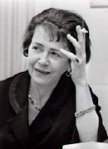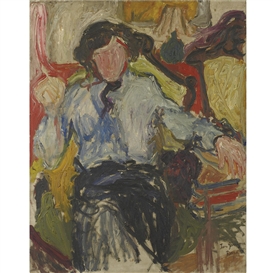 “Evansville-born poetess Jean Garrigue dies at 59,” trumpets the headline from the Indiana town where the poet spent the first four years of her life. Schadenfreude surely prompted the Evansville paper’s obit writer to quote Garrigue in the first paragraph: “I’ve never felt the flat land to be my very own home. I’m happy only in the mountains or cities with ports that lead to the sea.” In the next paragraph, the writer observes that the poet died in Boston’s Massachusetts General Hospital, “close to the sea and the city life she loved.”
“Evansville-born poetess Jean Garrigue dies at 59,” trumpets the headline from the Indiana town where the poet spent the first four years of her life. Schadenfreude surely prompted the Evansville paper’s obit writer to quote Garrigue in the first paragraph: “I’ve never felt the flat land to be my very own home. I’m happy only in the mountains or cities with ports that lead to the sea.” In the next paragraph, the writer observes that the poet died in Boston’s Massachusetts General Hospital, “close to the sea and the city life she loved.”
Born Gertrude Louise Garrigus in 1912, Garrigue later adopted the androgynous “Jean” as a first name and altered the surname because she felt “really more French than Irish.” Her postal inspector father received a promotion to the state capital, and Garrigue ended up graduating from Shortridge High School in Indianapolis, where so many of the city’s writers—Kurt Vonnegut, Marguerite Young, Dan Wakefield, and Janet Flanner—got their literary start. The high-powered school boasted a daily newspaper and offered instruction in French, Spanish, German, Latin, and Greek. Memoirist Honor Moore, who also was educated there a generation after Garrigue, remembers her chemistry teacher, Mrs. Henrietta Parker, had worked on the Manhattan Project.
At the University of Chicago, Garrigue roomed with the poet and novelist Marguerite Young, and they made a pact to leave the Midwest as soon as they were able. As a young woman, Garrigue bummed around Europe, then settled in Greenwich Village, where she threw herself into literary life, earning praise from James Laughlin, Marianne Moore, and Delmore Schwartz, and fell into relationships with both men and women. Her early poetry, J.D. McClatchy noted in his introduction to her Selected Poems, “resembled the creative mind itself: . . . self-reflexive, allusively cultured, with an aloof integrity” (xiv). It teemed with a folktale tableau of brooks and moons, forests and mirrors—symbolist icons that charted a path to the interior. John Ashbery, during his prep school days, remembered “a surreal, dreamlike quality” in Garrigue’s poems, “a strangeness that I sympathized with” (qtd. in McClatchy xiv).
During her long apprenticeship, Garrigue imitated many poets, but felt a particular affinity with Hart Crane and Dylan Thomas for their refusal merely to reflect external reality in their work, but instead to rival it with ornate diction and sonorous rhythms. Under their influence, Garrigue would write lines like “O nuptial drug and condiment of rite, / O tempter to an inwardness of sight, / Dwarfs, indigo, within whose opera, / O bridal jest, you circummortal us.”
Later, she would be known for her long poems, typically anchored in a place—Chartres, Venice, Amsterdam, the Grand Canyon. But her poems are not simple travelogues. Her Grand Canyon poem, written just after she was diagnosed with Hodgkin’s disease, instead dramatizes the self in collision with the world. It contains an 108-line sentence, which Roger Mitchell has termed “an elaborate, operatic performance of astonished joy” in its cataloguing of “tempests” and “waterspouts,” the “camber of columns, tawny rotundas of ruins,” “Aztec pyramidal temples . . . wet with sacrificial blood.” No mere natural wonder, Garrigue’s version of the Canyon excavates layers of ancient civilizations, whose surviving artifacts oppose death’s oblivion.
For contemporary readers unfamiliar with Garrigue, the excerpts I’ve cited no doubt seem like scented, embroidered handkerchiefs, remote from the plain style of our current age. But I’d like to focus on two poems, which would not be out of place in the pages of today’s literary magazines. The first originally appeared on New Year’s Day in The New Yorker in 1972, eleven months before Garrigue’s death:
Movie Actors Scribbling Letters Very Fast in Crucial Scenes The velocity with which they write— Don’t you know it? It’s from the heart! They are acting the whole part out. Love! has taken them up— Like writing to god in the night. Meet me! I’m dying! Come at once! The crisis is on them, the shock Drives from the nerve to the pen, Pours from the blood into ink. (Selected Poems 131)
Garrigue’s belief in poetry as a cry of the heart is still evident here, only ironized, refracted through the device of actors mouthing lines and pretending to be writers, instead of speaking sincerely as the self. As Lee Upton has indicated, Garrigue was fond of telling her students that “Every line in a poem is an autobiography” (14).
Garrigue’s “Requiem,” a prose poem written after the death of her lover, socialist writer Josephine Herbst, in 1969, also adopts a plainer style for evoking grief:
Requiem
In the sudden white silence, where are you? It seems I
carry a letter to you, but the mouth of the mailbox is choked
with snow and the box billows, swollen to twice its size by the thick
coating of so many flakes already fallen for hours.
I think then to telephone you, seeing a booth, its panes
pasted over and opaque like a half-marbled sentry box.
But the floor is so deep in snow that I cannot pull the door
to. Even the books are thick in it and the mouthpiece is
sifted over.
Balked, I walk into the park of the trees of this new
foliage, false orchard bewildering like a fruitless spring.
From afar strikes one bell practising to be heard.
Is it you calling?
No. Only my heart tolling. (Selected Poems 143)
Written in paragraphs, this poem has the feel of a casual sonnet, with each paragraph functioning like a quatrain in which the speaker’s inability to communicate with her dead lover is signaled by a different image: a stuffed mailbox, a phone booth filling up with snow, a “false orchard.” And the slant-rhymed final lines sum up the inability to connect like a couplet might.
Helen Vendler and Harry R. Moody have written about poets and painters simplifying their styles near the end of their lives. There’s the nearly blind Monet freeing his brushstroke in his late, radiant paintings of waterlilies. Or Elizabeth Bishop’s “Sonnet,” thought to be the last poem she wrote, which alters features of the familiar, fourteen-line form, shortening the lines and inverting octave and sestet, to express the sense of relief death can bring. So it is with late Garrigue, still ardent, if renouncing the “[d]ew-drenched, liquid-kissing, cyclamen-haunted” poems of her earlier years.
See J.D. McClatchy’s introduction to Garrigue’s Selected Poems (University of Illinois Press, 1992), Lee Upton’s Jean Garrigue: A Poetics of Plenitude (Fairleigh Dickinson University Press, 1991), and Roger Mitchell’s blog entitled “Some Thoughts on Garrigue’s ‘Grand Canyon.’”
Larry Rivers’ portrait, Jean Garrigue, ca. 1951

